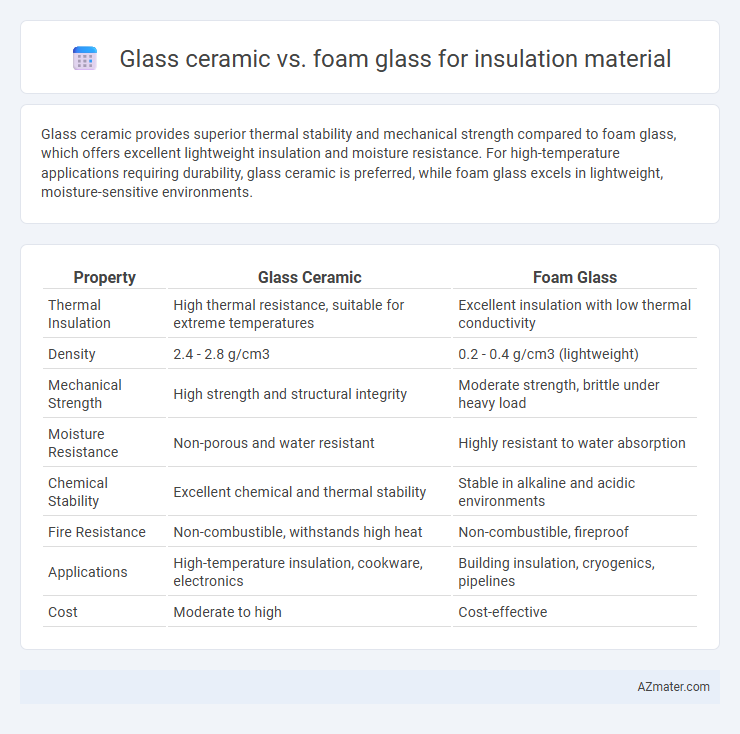Glass ceramic provides superior thermal stability and mechanical strength compared to foam glass, which offers excellent lightweight insulation and moisture resistance. For high-temperature applications requiring durability, glass ceramic is preferred, while foam glass excels in lightweight, moisture-sensitive environments.
Table of Comparison
| Property | Glass Ceramic | Foam Glass |
|---|---|---|
| Thermal Insulation | High thermal resistance, suitable for extreme temperatures | Excellent insulation with low thermal conductivity |
| Density | 2.4 - 2.8 g/cm3 | 0.2 - 0.4 g/cm3 (lightweight) |
| Mechanical Strength | High strength and structural integrity | Moderate strength, brittle under heavy load |
| Moisture Resistance | Non-porous and water resistant | Highly resistant to water absorption |
| Chemical Stability | Excellent chemical and thermal stability | Stable in alkaline and acidic environments |
| Fire Resistance | Non-combustible, withstands high heat | Non-combustible, fireproof |
| Applications | High-temperature insulation, cookware, electronics | Building insulation, cryogenics, pipelines |
| Cost | Moderate to high | Cost-effective |
Introduction to Glass Ceramic and Foam Glass
Glass ceramic is a non-porous, crystallized material created by controlled crystallization of certain glasses, offering high thermal stability and mechanical strength ideal for insulation applications in extreme temperature environments. Foam glass, made from recycled glass powder combined with foaming agents and heat, provides lightweight, closed-cell insulation with excellent moisture resistance and compressive strength, commonly used in building and industrial insulation. Both materials deliver efficient thermal insulation but differ in structure, application scope, and performance characteristics based on their manufacturing process and material properties.
Composition and Manufacturing Processes
Glass ceramic insulation is produced by controlled crystallization of certain glasses, involving heat treatment that transforms the glass into a material with fine-grained crystalline phases, typically composed of silica, alumina, and alkaline earth oxides. Foam glass insulation is made by foaming crushed recycled glass mixed with a foaming agent, often carbon or carbon compounds, at high temperatures to create a lightweight, closed-cell structure predominantly consisting of amorphous silica and soda-lime glass. The manufacturing process for glass ceramics demands precise thermal treatment to induce crystallization, whereas foam glass relies on gas expansion within molten glass to form porous, insulating blocks.
Thermal Insulation Properties
Glass ceramic offers superior thermal insulation with low thermal conductivity, typically around 0.06-0.10 W/m*K, providing excellent resistance to heat transfer in high-temperature applications. Foam glass insulation, with a thermal conductivity ranging from 0.03 to 0.06 W/m*K, excels in moisture resistance and long-term durability while maintaining effective insulation performance. Both materials provide efficient thermal barriers, but foam glass is preferred for environments requiring additional moisture protection and lightweight properties.
Mechanical Strength and Durability
Glass ceramic insulation exhibits superior mechanical strength, offering enhanced resistance to compression and impact compared to foam glass. Foam glass, while lightweight and highly resistant to moisture, typically has lower load-bearing capacity and may be more prone to fracturing under heavy mechanical stress. Durability-wise, glass ceramic materials maintain structural integrity and thermal performance over extended periods, even in harsh environments, whereas foam glass can degrade faster when exposed to cyclic loading or thermal fluctuations.
Fire Resistance and Safety Factors
Glass ceramic insulation offers superior fire resistance due to its high melting point and non-combustible nature, making it ideal for applications requiring enhanced safety. Foam glass insulation, while also non-combustible and fire-resistant, provides excellent thermal insulation but may have lower structural stability under extreme heat compared to glass ceramics. Both materials meet stringent fire safety standards, but glass ceramics generally deliver better long-term performance in high-temperature environments.
Environmental Impact and Sustainability
Glass ceramic insulation offers high durability and recyclability, reducing waste and the demand for virgin raw materials, which mitigates environmental impact. Foam glass insulation, made from recycled glass, excels in sustainability by promoting circular economy principles and providing excellent thermal performance with zero off-gassing or VOC emissions. Both materials contribute to green building certifications, but foam glass typically has a lower embodied carbon footprint due to its manufacturing process.
Moisture and Chemical Resistance
Glass ceramic insulation offers superior chemical resistance due to its dense and non-porous structure, making it highly resistant to moisture absorption and chemical attack. Foam glass, characterized by its cellular structure filled with closed glass cells, also provides excellent moisture resistance, preventing water penetration and offering strong chemical inertness against acids and alkalis. Both materials excel in harsh environments, but foam glass tends to be lighter and more effective in maintaining thermal insulation with minimal moisture retention.
Applications in Construction and Industry
Glass ceramic insulation excels in thermal stability and mechanical strength, making it ideal for high-temperature industrial furnaces, aerospace components, and building facades requiring thermal resistance and durability. Foam glass insulation offers superior compressive strength, moisture resistance, and lightweight properties, widely used in construction for rigid insulation in roofing, flooring, and walls, as well as in industrial pipelines and cold storage facilities. Both materials provide energy efficiency and fire resistance, but foam glass is preferred for moisture-prone environments, while glass ceramic suits applications demanding structural integrity under extreme thermal conditions.
Cost Comparison and Economic Viability
Foam glass insulation generally incurs higher initial costs compared to glass ceramic due to specialized manufacturing processes and raw material expenses. Glass ceramic offers more economical pricing, making it a preferred choice for large-scale projects requiring cost efficiency. Evaluating long-term energy savings and durability also underscores glass ceramic's economic viability in budget-sensitive insulation applications.
Choosing the Right Material: Key Considerations
Glass ceramic insulation offers superior thermal stability and mechanical strength, making it ideal for high-temperature applications and structural support. Foam glass insulation provides exceptional moisture resistance, lightweight properties, and effective thermal insulation, suitable for damp environments and where weight savings are critical. Choosing the right material depends on factors such as operating temperature, exposure to moisture, mechanical load requirements, and long-term durability needs.

Infographic: Glass ceramic vs Foam glass for Insulation material
 azmater.com
azmater.com